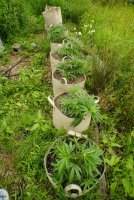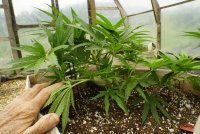Simon Limon
Well-Known Member
I'm new to cannabis cultivation but not at all new to gardening. Began using CBD oil several months ago for chronic PTSD and physical pains, which led me to realize I could perhaps grow this stuff myself and save some $$. An acquaintance gave me two tiny Dutch Hawaiian clones but I figured it would be better to have some backup plants so I bought ten more clones: Critical Mass.
Everything I know about this came from this website and YouTube, plus my experience with genuine tomatoes.
The soil is in 20 gallon fabric pots, a mix of Fox Farm Ko Ko Bop (12 gallons) and local processed dairy compost (6 gallons). Nine of the CM and one DH are in the greenhouse and the other CM and DH are outside, just for the heck of it.
The Ko Ko Bop and all of the nutrients I'm using were suggested by a hydro store.
I'm watering each plant about every 4 days with one gallon of spring water and a light dose of Pure Blend Pro. Every 5 days they get a foliar application of "Green Magic".
The Dutch Hawaiian came with a few spider mites so I've treated every plant with Azamat. If any survived I haven't yet seen them.
I really enjoy fiddling with the plants so I'm doing some training by bending the main stem almost horizontal and pinning it down using 3 and 6 inch garden staples. These staples are very easy to work with, especially on the more tender branches.
I've done a FIM on the DH plants but I'm not really sure about this method -- especially what to do next. I'll include a photo if anyone has suggestions.
As for the other plants which I'm pinning down, I'm also not sure where this is headed, other than trying to keep them short and easy to manage. Should I be pinching off the ends of the main stems or side shoots?
The foliage is becoming quite dense so I suppose it would be good to remove some of the big leaves?
My final concern is the potential size of the harvest. The guy who gave me my first clones just confessed that the yield of his plants is far far greater than his personal use. I didn't do any research on yield until after buying the ten clones so this is looking like a case of "be careful what you wish for"!
I do have a legal permit for these plants.
By the way: the greenhouse is 14 x 20 feet and is made of light cedar board trusses with plywood gussets. It is all glued and stapled together, then covered with 6 mil UV protected plastic. Very light but also quite strong, sheds snow quite well. Cheap!











Everything I know about this came from this website and YouTube, plus my experience with genuine tomatoes.
The soil is in 20 gallon fabric pots, a mix of Fox Farm Ko Ko Bop (12 gallons) and local processed dairy compost (6 gallons). Nine of the CM and one DH are in the greenhouse and the other CM and DH are outside, just for the heck of it.
The Ko Ko Bop and all of the nutrients I'm using were suggested by a hydro store.
I'm watering each plant about every 4 days with one gallon of spring water and a light dose of Pure Blend Pro. Every 5 days they get a foliar application of "Green Magic".
The Dutch Hawaiian came with a few spider mites so I've treated every plant with Azamat. If any survived I haven't yet seen them.
I really enjoy fiddling with the plants so I'm doing some training by bending the main stem almost horizontal and pinning it down using 3 and 6 inch garden staples. These staples are very easy to work with, especially on the more tender branches.
I've done a FIM on the DH plants but I'm not really sure about this method -- especially what to do next. I'll include a photo if anyone has suggestions.
As for the other plants which I'm pinning down, I'm also not sure where this is headed, other than trying to keep them short and easy to manage. Should I be pinching off the ends of the main stems or side shoots?
The foliage is becoming quite dense so I suppose it would be good to remove some of the big leaves?
My final concern is the potential size of the harvest. The guy who gave me my first clones just confessed that the yield of his plants is far far greater than his personal use. I didn't do any research on yield until after buying the ten clones so this is looking like a case of "be careful what you wish for"!
I do have a legal permit for these plants.
By the way: the greenhouse is 14 x 20 feet and is made of light cedar board trusses with plywood gussets. It is all glued and stapled together, then covered with 6 mil UV protected plastic. Very light but also quite strong, sheds snow quite well. Cheap!






